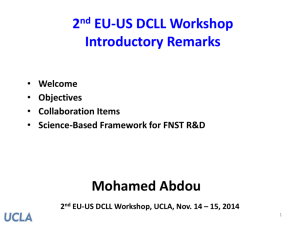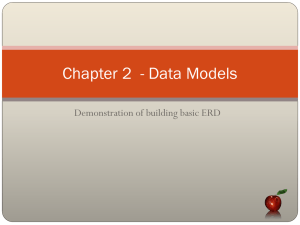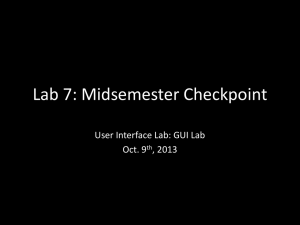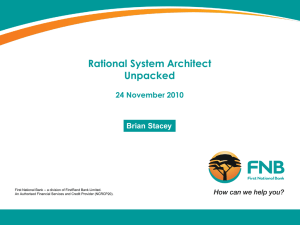EU DEMO project - Fusion Research Group
advertisement
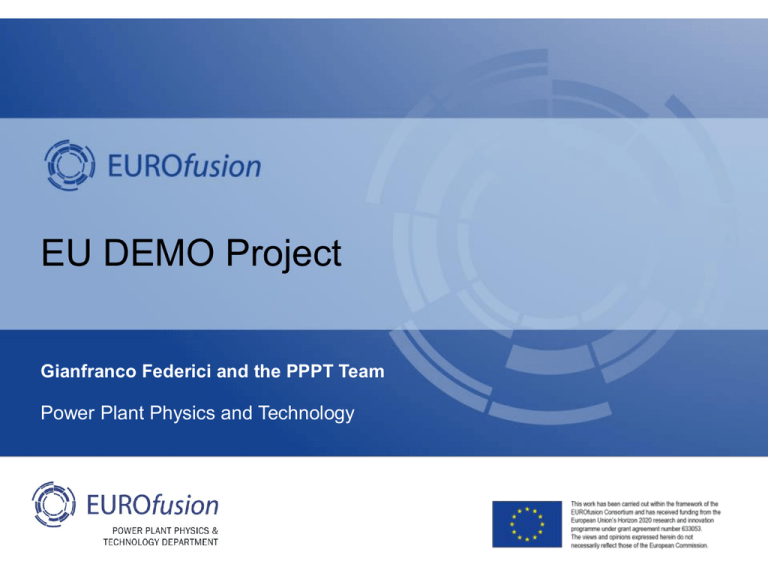
EU DEMO Project Gianfranco Federici and the PPPT Team Power Plant Physics and Technology Outline • Background/ Context • Design approach • Preliminary design choices • Main Design and R&D Priorities, e.g.: Power exhaust / divertor Tritium breeding / power extraction blanket Remote Maintenance • PPPT Implementation • Conclusions G. Federici | 2nd EU-US DCLL Workshop | UCLA (USA)| 14-15/11/2014| Page 2 A roadmap to the realisation of fusion energy 8 Strategic missions to address challenges in two main areas: ITER Physics Risk mitigation for ITER JET, Medium Size Tokamaks, PFC devices DEMO Design Conceptual design studies A single step to commercial fusion power plants Production of electricity with a closed fuel cycle Back-up strategy Stellarator Three periods (ITER on critical path/ schedule uncertainties) • 2014 – 2020 (Building ITER & support experiments + DEMO CDA) • 2021 – 2030 (Exploiting ITER and DEMO EDA) • 2031 – 2050 (Building and Exploiting DEMO) Important to increase the involvement of industry PPPT Projects (total ~110 M€) 2014-18 EC contribution (~55%) G. Federici | 2nd EU-US DCLL Workshop | UCLA (USA)| 14-15/11/2014| Page 3 Outstanding technical challenges with potentially large gaps beyond ITER • Still a divergence of opinions on how to bridge the gaps to fusion power plants • Most of the issues are common to any next major facility after ITER ITER will show scientific/engineering feasibility: – Plasma (Confinement/Burn, CD/Steady State, Disruption control, edge control) – Plasma Support Systems (LTSC magnets, fuelling, H&CD systems) Most components inside the ITER VV are not DEMO relevant, e.g., materials, design. TBM provides important information, but limited scope. DEMO Issues/gaps T breeding blanket technology (M4) Safety and licensing (M5) Remote maintenance and plant availability (M6) Divertor design configuration and technology (M2 & M6) Plant design integration incl. BoP (M6) Operating plasma scenario and control and efficient CD systems (M1) For any further step, safety, power exhaust, breeding, RH and plant availability are important design driver and CANNOT be compromised G. Federici | 2nd EU-US DCLL Workshop | UCLA (USA)| 14-15/11/2014| Page 4 Advanced Reactor Designs Development Paradigm: Fission Power Plants Safe Operation T Self Sufficiency Availability Power Handling Cost Thermal Efficiency Electrical Output = KPI Partially Met (DEMO 1) = KPI Fully Met = Tech advancement needed to reach KPI targets (DEMO 1) = Further Tech advance to fully reach KPI target (DEMO 2) Increasing Expected Performance Short Pulse…………………………….………………..Pulse Length………………………………..………………Steady State Ceramic / LiPb Breeder / Eurofer…..…………..Blanket Technology……………………….…….LiPb / SiC/ DCLL EUROFER <550C…………………………Max Temp. Structural Materials …………ODS RAFM/ HT FM> 600C Conventional…..……………………………..…………..Divertor Configuration………………………Advanced Novel Costs of Development (prior to commercial deployment) ITER (low availability) LTSC Coils…………………………………….…….Magnet Technology….……………………………..HTSC with Joints Decreasing Technology Readiness Departure from Existing Designs (=ITER) Evolutionary designs, GEN III Evolution thanks mainly to advances in safety, materials and technology (+ strong involvement of industry from beginning Confirmation testing+ Engineering Existing operating plants (high availability) Innovative designs, i.e., design requiring substantial developments, GEN IV Substantial R&D Prototype and/or DEMO plant + Confirmatory testing + Engineering Departure from Existing Designs G. Federici | TOFE 2014| Anaheim (USA)| 12/11/2014| Page 5 Basic Concept Design Approach Define Requirements Develop Design Conduct R&D Evaluate Design Performance Decision Point: develop further? • Design integration essential from the early stage to identify requirements for technology R&D Refine Design • A systems engineering approach is needed to identify design trade-offs and constraints; and prioritize R&D • Ensuring that R&D is focussed on resolving critical uncertainties in a timely manner and that learning from R&D is used to responsively adapt the technology strategy is crucial. • Clear assessment methodology needed e.g., by assigning a TRL and updating TRL as R&D tasks are completed • Involvement of industry is highly desirable • Lessons learned from the pas G. Federici | 2nd EU-US DCLL Workshop | UCLA (USA)| 14-15/11/2014| Page 6 Readiness of assumptions • Operational point (in terms of Beta N, q95, n/nGW, and H) should lie within the existing database of tokamak discharges that have run for at least several current redistribution times, implying that we also know how to control these scenarios. • Credible and sufficient power exhaust protection. • Adequate breeding coverage area. Divertor heat load and H-mode limits as a machine size driver Psep/PLH • Power transported by electrons and ions across separatrix: Psep=Pα+Padd-Prad,core • Material Limit Condition for divertor : Psep/R≤20MW/m Psep,maxR • Boundary condition to access and stay in H-mode (PLHR): Psep ≥ PLH Psep,minR PROCESS: Fix Pel,net, pulse Scan Zeff Psep/R Prad,core/Prad,tot R. Kemp (CCFE) G. Federici | 2nd EU-US DCLL Workshop | UCLA (USA)| 14-15/11/2014| Page 7 EU DEMO design point studies • Systems Code PROCESS to develop self-consistent design points. – Rather than focusing solely on developing the details of a single design point keep some flexibility at the beginning – Reasonable readiness of physics and technology assumptions – Identify key driver and constraints (e.g., divertor protection, vertical stability) – Sensitivity to design assumptions and impact of uncertainties [R. Kemp, IAEA/ FEC 2014 St. Petersburg] (e.g., Pulsed vs steady-state, A=R/a, TF Ripples, Divertor Protection) • Iterate between the Systems Code and more detailed analysis such as integrated scenario modelling with transport codes (refine design space) – Preliminary plasma scenario modelling [G. Giruzzi, IAEA/ FEC 2014 St. Petersburg] – DEMO pedestal predictions [R. Wenninger, IAEA/ FEC 2014 St. Petersburg] • This approach provides confidence in the choice of the operating point G. Federici | 2nd EU-US DCLL Workshop | UCLA (USA)| 14-15/11/2014| Page 8 Preliminary DEMO design options being studied Aspect ratio trade-off studies are underway A=2.6 A=3.1 A=3.6 Design features (near-term DEMO): • • • • • • • • • • 2000 MWth~500 Mwe Pulses > 2 hrs Single-null water cooled divertor PFC armour: W LTSC magnets Nb3Sn (grading), Bmax conductor ~12 T (depends on A) RAFM (EUROFER) as blanket structure Vacuum Vessel made of AISI 316 Blanket vertical RH / divertor cassettes Lifetime: starter blanket: 20 dpa (200 appm He); 2nd blanket 50 dpa 2nd, divertor: 5 dpa (Cu) Under revision Inductive (2.6) Steady State R0 / a (m) 9.0/ 2.8 8.1/ 3 Κ95 / δ95 1.6/ 0.33 1.6/ 0.33 A (m2)/ Vol (m3) 1687/ 3515 1318/ 2363 Open Choices: H-factor / BetaN 1.1/ 2.8 1.3/ 3.4 • Breeding blanket design concept selection planned for 2020 Psep 150 100 2040/ 500 2104/ 500 24/ 35% 19.9/ 56% B at R0 (T) 4.2 5.0 Bmax conductor (T) 9.8 12.2 • Primary Blanket Coolant/ BoP • Protection strategy first wall (e.g., limiters) • Advanced divertor configurations • Number of coils PF (MW) / PNET (MWe) Ip (MA) / fbs BB i/b / o/b (m) NWL MW/m2 1.07/ 1.56 0.9 1.2 G. Federici | 2nd EU-US DCLL Workshop | UCLA (USA)| 14-15/11/2014| Page 9 Enabling DEMO Reactor Technologies • Important experience relevant for DEMO is expected to be gained by the Construction, Commissioning and Operation of ITER. • Modest R&D, for some of the components, foreseen in Horizon 2020 Readiness after ITER Readiness Now Water BoP (TRL 7-8) Divertor RH ECH 170 GHz He BoP (TRL 4-5) Nb3Sn LTSC (TRL 4) NB (1MeV) (TRL 3) Blanket RH (TRL 1-2) Cryopumps Nb3Sn LTSC NB (1MeV) Divertor RH (TRL 7-8) ECRH 170 GHz (TRL 6-7) Blanket RH (TRL 4) Diagnostics not fully relevant (TRL 3 – 4) G. Federici | 2nd EU-US DCLL Workshop | UCLA (USA)| 14-15/11/2014| Page 10 Divertor configuration and target R&D Strategy • Heat flows in a narrow radial layer (SOL) of width λq (~1 mm) • Scales only weakly with machine size [T. Eich 2013]. ITER • Single-null divertor • Water –cooled, 100oC (inlet) • W armour/ Cu-alloy as heat sink • Targets qualified for 20 MW/m2 Physics DEMO Conventional divertors • Stability of detachment • ELMs and Disruptions • Sweeping/ Wobbling Advanced divertors • Snowflakes • Super-X • Liquid Metals Technology TRL • • • • Water cooled design • Armour: Tungsten Structural: Cu-alloys EOL <10 dpa, 200-350oC Limited effort on Hecooling and on LM • • • Very LOW readiness Forces on the PF coils are the critical issue Plasma control problems Design integration problems G. Federici | 2nd EU-US DCLL Workshop | UCLA (USA)| 14-15/11/2014| Page 11 Encouraging recent results from Asdex-Upgrade Divertor heatflux control with nitrogen seeding A. Kallenbach, IAEA / FEC 2014 Psep / R = 10 MW/m ! Psep/R is divertor identity parameter, provided similar density and power width q Here: (weak) partial detachment 1/3 cryo, p0,div = 4 Pa Room for stronger detachment? simpler and cheaper divertor ! G. Federici | 2nd EU-US DCLL Workshop | UCLA (USA)| 14-15/11/2014| Page 12 DEMO breeding blanket: very low TRL No one is perfect!!! • Tritium Breeding Blankets - the most important & novel parts of DEMO • Large knowledge gaps will exist even with a successful ITER TBM programme • Feasibility concerns and Performance uncertainties Selection now is premature Concerns HCPB HCLL WCLL DCLL ☺ Tested in ITER TBM Suitability for Eurofer FW heat flux capability Safety issues of coolant Technology readiness BoP Potential for high coolant outlet temperature Coolant pumping power Shielding efficiency/ n-streaming void space Activation products in coolant (water) Breeding efficiency Tritium extraction from breeder Tritium extraction from coolant Tritium permeation through heat exchanger G. Federici | 2nd EU-US DCLL Workshop | UCLA (USA)| 14-15/11/2014| Page 13 EU Blanket Designand R&D Strategy (talk of L. Boccaccini) • Develop a feasible and integrated DEMO blanket system conceptual design of 4 concepts. • BoP cycle and technology plays a substantial role in concept selection. Complementarity with TBM Programme G. Federici | 2nd EU-US DCLL Workshop | UCLA (USA)| 14-15/11/2014| Page 14 Remote Maintenance Architecture Analysis Vertical port maintenance preferred: From a range of designs examined in 2011, options to 4 quasi-vertical alternatives went forward… ITER, Aries, NET, and free thinking alternatives CAD models created: • Kinematic studies determine optimum design for maintenance Vertical port maintenance preferred: • Simpler pipe handling Through the floor Large upper maintenance port opening (NET) Diverter on the roof Courtesy of A. Loving and his team, CCFE Straight vertical port • Ease of inboard segment extraction • Access to connection points for a crane G. Federici | TOFE 2014| Anaheim (USA)| 12/11/2014| Page 15 Involvement of Industry Areas of potential industrial involvement: • Technical Management 1. Project / Programme Management 2. Plant engineering processes: Systems Engineering and Design Integration 3. Cost, risk, safety and RAMI analysis 4. Evaluation and selection of design alternatives 5. Plant engineering tools, modelling and simulation 6. Technology assessment i.e. technology audits, TRL assessment, technology scenario analysis i.e. where are relevant technologies (e.g. HTS) going over the next 5 years?, etc. • Design Engineering 1. Design for robustness and manufacture of critical components/systems; include design simplification/ reduce fabrication costs 2. Impact assessment on the application of existing technologies under DEMO environmental / operating conditions i.e. pulsed operation on BoP components 3. Manufacturing development and qualification with emphasis on performance and cost optimization of design solutions G. Federici | 2nd EU-US DCLL Workshop | UCLA (USA)| 14-15/11/2014| Page 16 PPPT Implementation • A project-oriented structure set-up • Resources in Horizon 2020 secured • A new governance system based on the principle of joint programming G. Federici | 2nd EU-US DCLL Workshop | UCLA (USA)| 14-15/11/2014| Page 17 PPPT Project Leaders Current Status of PPPT Projects: • Well defined scope of work / deliverables / milestones / resources • Interlinks /opportunities for industrial involvement + training • All PMPs approved by Project Boards Early Neutron Source N. TAYLOR L. ZANI Safety and Environment Magnets L. BOCCACCINI Breeding Blanket PPPT PMU Project control/ coordination System & Design Integration Containment Structure Physics Integration M. RIETH J. H. YOU Materials Divertor M. Q. TRAN A. LOVING Remote Maintenance W. BIEL Diagnostics, Control E. CIPOLLINI Heat transfer, Balance of Plant, Sites C. DAY Heating and Current Drive Tritium, Fuelling and Vacuum G. Federici | 2nd EU-US DCLL Workshop | UCLA (USA)| 14-15/11/2014| Page 18 PPPT PMU Team GIANFRANCO FEDERICI Head of Department System and design integration Project control Physics integration CLAUDIUS MORLOCK MARK SHANNON RONALD WENNINGER Project Control Group Manager Systems Engineering and Design Integration Group Manager Physics Integration Group Manager CHRISTIAN BACHMANN System Level Analysis and Project Coordination Officer ? Senior Breeding Blanket Project Control and Integration Officer Blanket design integration WPBB project RO WPTFV project RO Design integration System level analysis WPDIV project RO WPCS project RO FRANCESCO MAVIGLIA Plasma Engineering and Analysis Support Officer THOMAS FRANKE Plasma engineering analysis Engineering data model management Design Integration and Project Coordination Officer Auxiliary systems design integration WPHCD project RO WPDC project RO/ engineering integration SERGIO CIATTAGLIA BOTOND MESZAROS Senior Configuration control and CAD management officer Design integration CAD management Senior Plant Safety Design Integration Officer EBERHARD DIEGELE Senior Material Project Control and Integration Officer Safety design integration WPSAE project RO WPBOP project RO Materials and design criteria WPMAT project RO HELMUT HURZLMEIER Senior CAD operator MATTI COLEMAN Design Integration and Project Coordination Officer Plant design integration and modelling WPMAG project RO WPRM project RO CAD management CAD operations G. Federici | 2nd EU-US DCLL Workshop | UCLA (USA)| 14-15/11/2014| Page 19 PPPT: allocated by Research Units (EC/k€), 2014-2018 Grand Total / EC (k€) #RUs Balance of Plant 1,731 4 Breeding Blanket 24,503 7 Containment structures 861 n.a. Diagnostic and control 1,205 n.a. Divertor 4,753 6 Early Neutron Source definition and design 14,551 n.a. H&CD systems 5,852 11 Magnet system 3,552 13 Materials 29,375 22 Plant level system engineering, design integration and physics integration Remote maintenance system 7,330 14 7,973 7 Safety 4,291 7 Tritium Fuelling and vacuum system Grand Total 2,443 8 108,420 G. Federici | 2nd EU-US DCLL Workshop | UCLA (USA)| 14-15/11/2014| Page 20 PMU Key Functions Project Coordination and Control: Scope, Schedule/ Resources Design and Physics Integration • • Requirements Analysis • Stakeholder Requirements Definition / Plant Requirements Analysis Plant Design Definition and Optimisation • Plant Design Optimisation Studies • An Independently moderated TRL Assessment. • A Parameter trade off assessment and prioritisation exercise. » » » » • • • • Aspect Ratio Scan: Development of a blanket attachment system Recirculating Electrical Power Requirements Sweeping of Divertor Strike Points • A Critical Decision Making Process System Level Analysis & Plant Engineering Studies Systems Engineering Framework and Technical Processes • • Definition of a Systems Engineering Framework CAD configuration management Project Management Activities • • • Definition of Deliverables for the CDA Formation and Maintenance of the Master Schedule Interface Management DEMO Physics Integration • • • System Code Analysis and Development of Point Design Options DEMO Physics Basis Development DEMO Physics Design Integration G. Federici | 2nd EU-US DCLL Workshop | UCLA (USA)| 14-15/11/2014| Page 21 Summary • The demonstration of electricity production before 2050 in a DEMO Fusion Power Plant is a priority for the EU fusion program • ITER is the key facility in this strategy and the DEMO design/R&D is expected to benefit largely from the experience gained with ITER construction • Nevertheless, there are still outstanding gaps requiring a vigorous integrated design and technology R&D (e.g., breeding blanket, divertor, materials) • Design integration essential from the early stage to identify requirements for technology and physics R&D • A systems engineering approach is needed to identify design trade-offs and constraints; and prioritize R&D • Ensuring that R&D is focussed on resolving critical uncertainties in a timely manner and that learning from R&D is used to responsively adapt the technology strategy is crucial • Involvement of industry from the early stage is desirable G. Federici | 2nd EU-US DCLL Workshop | UCLA (USA)| 14-15/11/2014| Page 22 EUROfusion Consortium 29 members in 27 EU countries Thank you for your attention AcknowledgmentsAny Questions? PPPT PMU Team: R. Wenninger, F. Maviglia, M. Shannon, C. Bachmann, B. Meszaros, T. Franke, S. Ciattaglia, E. Diegele, M. Coleman, H. Hurzlmeier, C. Morlock PPPT Distributed Project Team Leaders: L. Boccaccini (WPBB), J-H You (WPDIV), E. Cipollini (WPBOP), T. Loving (WPRM), L. Zani (WPMAG), M. Rieth (WPMAT), W. Biel (WPDC), M.Q. Tran (WPHCD), C. Day (WPTFV), N. Taylor (WPSAE) IPH PMU Team: X. Litaudon, D. McDonald Eurofusion PM: T. Donne F. Romanelli G. Federici | TOFE 2014| Anaheim (USA)| 12/11/2014| Page 23 Additional slides G. Federici | TOFE 2014| Anaheim (USA)| 12/11/2014| Page 24 DEMO IVCs lifetime design requirements and materials issues Main Chamber wall/ Breeding Blanket Divertor: life limiting phenomena is erosion S. Kecskes (KIT, 2013) q> 10 MW/m2 Armour: Tungsten HS: Cu-alloys Coolant: Water Physical sputtering (Te~5 eV) will limit the lifetime of the diveror to 1-2 FPY Armour: W Structural: EUROFER97 Damage in FW steels: 10 dpa/fpy Starter blanket≈20 dpa; ~6000 cycles. 2nd blanket: 50 dpa Material issues • • • • Low-temp. embrittlement of Eurofer (WCLL) Decline in strength above 550°C Creep-rupture limits operation to <550°C for >12 103h Lack of Design-code development Advanced Steels • RAFM steels for water-cooled applications • Adv. Steel for High Temperature applications • ODS RAFM steels for high temp strength. Material issues (Cu-Cr-Zr) Engineering Data and Design Integration • Radiation-induced • Materials Database and Handbook embrittlement <~200°C • Structural Design Criteria • Softening > 350°C • Testing in fission reactors (HFIR, BOR-60) • Irradiation data needed • IFMIF/ ENS Damage in Cu: 35dpa/fpy, up to 2 fpy (replacement) G. Federici | 2nd EU-US DCLL Workshop | UCLA (USA)| 14-15/11/2014| Page 25

